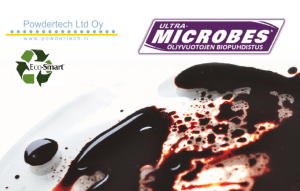
Supercharging Mother Nature
What is the best way to clean up oil spills after they occur? Nature has this down to a science. Wherever there is a natural oil seepage on the earth, nature has placed oil degrading microorganisms (microbes) into that environment. Nature is able to clean up after itself, but it takes time. It’s a slow, natural healing process – nature’s own pollution control. The problem is that mankind now puts far more hydrocarbon pollution into the environment than nature can quickly remove. UltraTech has a 100% natural way of speeding up nature. By adding Ultra-Microbes to a contaminated environment, we can speed up the rate of natural degradation and help the bio-remediation process occur in days and weeks rather than months or years.
Where do they come from?
Ultra-Microbes are a consortium of three different types of microbes that are cultivated from rugged environments such as undersea vents or sites where there is volcanic activity. They are then bred and naturally enhanced in sea water and ammonia using sweet Texas crude oil as their only food source.
100% Natural
The result is 100% natural, hardy and fast-acting microbes that have an affinity for oil and other hydrocarbons, as well as organic waste. This specific consortium of microbes (Ultra-Microbes) has not been genetically altered or engineered. These naturally occurring microbes have been on the EPA National Contingency List since its inception.
How do they work?
Ultra-Microbes will digest hydrocarbon molecules and break them down into harmless by-products of carbon, carbon dioxide and lipids (a natural, soluble fatty material that is food for fish and plants). The more complex the hydrocarbon, the longer this process may take (for example, kerosene and diesel will be consumed more quickly than motor oil). This naturally occurring process is supercharged by adding these specific microbes to any oil spill or contaminated area (see below). It infuses as many as 5 billion microbes per gram into an oil spill, greasy catch basin, oil/water separator, etc. and within hours these microbes have reproduced from billions per gram to trillions. With water, oxygen and an organic food source (such as oil) these microbes will form vast colonies and digest and remediate oil on land and on water, as well as grease traps, septic tanks, storm drains and almost any other area where contaminants are present.
What happens to them when they are “done”?
After approximately ninety days or when the microbes have been deprived of water, oxygen, or a food source, the microbe colony will begin to naturally die off. How are they shipped? The Ultra-Microbes are shipped dormant in a bentonite-clay based carrier. When the carrier dissolves in water, the microbes become activated and water may become temporarily murky due to the infusion of the clay.
What else do I need to know?
Ultra-Microbe products should be stored and applied between 4 °C and 49 °C (40–120 °F). Temperatures outside that range may cause the microbes to become ineffective. Ultra-Microbes should not be exposed to radiation. Ultra-Microbes should only be used in applications where the pH is between 5.5 and 9.5. Visit www.ultramicrobes.com to view FAQs and test data.
MICROBES – oil-eating soil and water purifiers.
Finnish = FI English = EN
![]() Shakers,_WS_packets,_bulk_bags,_booms_FI.pdf
Shakers,_WS_packets,_bulk_bags,_booms_FI.pdf![]() Microbes Usein kysyttyä.pdf
Microbes Usein kysyttyä.pdf![]() Mircrobes sirottimen käyttöohje_FI.pdf
Mircrobes sirottimen käyttöohje_FI.pdf
